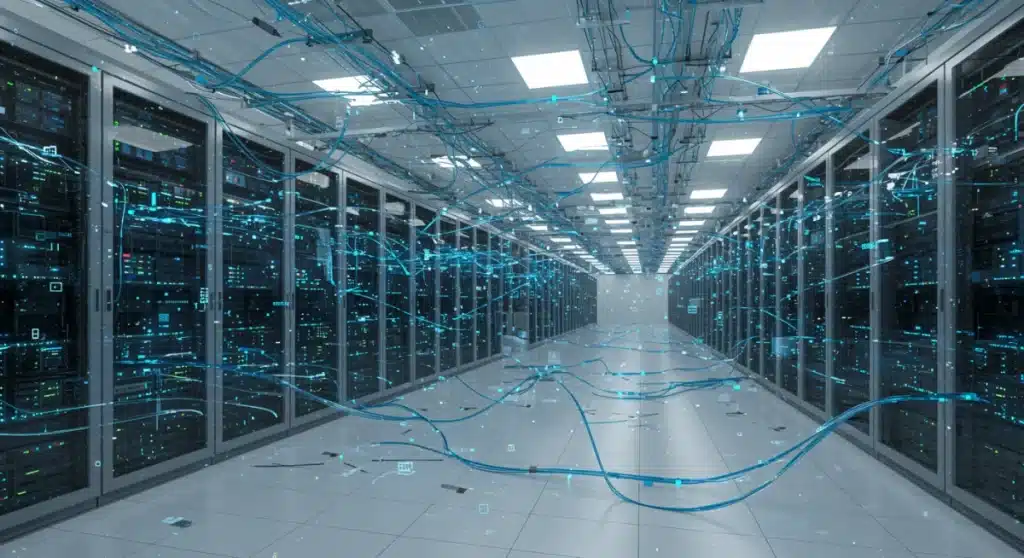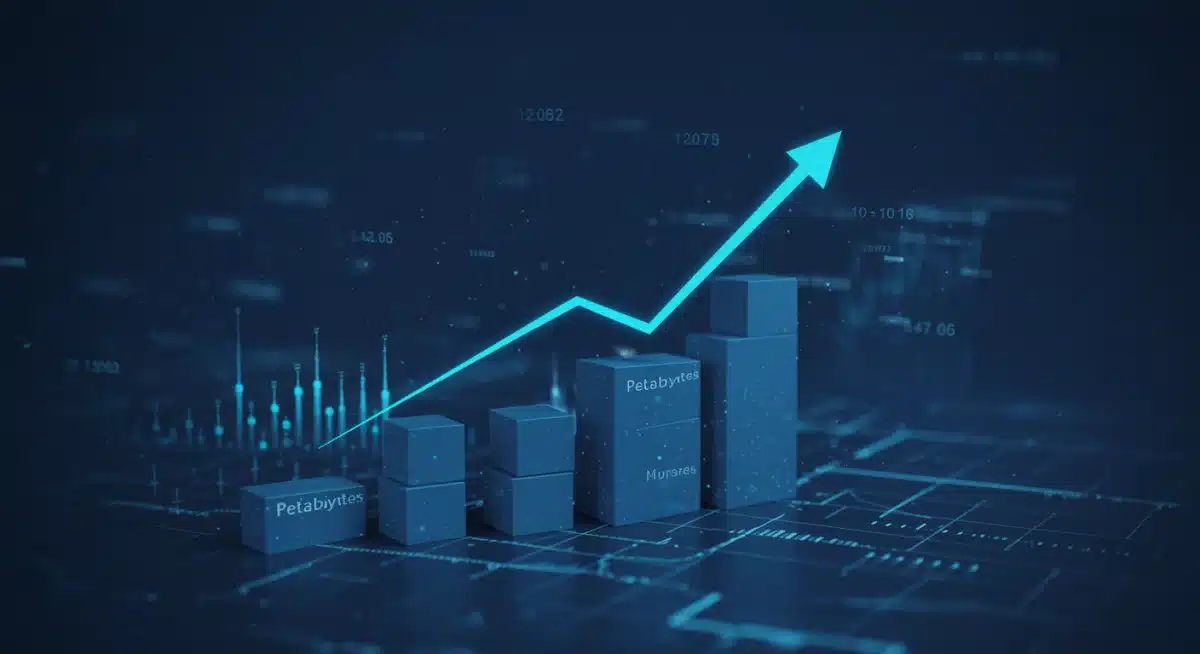Next-Gen Data Storage: Archiving Solutions for 100+ Petabytes by 2026

The digital age continues to generate data at an unprecedented rate, pushing the boundaries of current infrastructure. As organizations brace for the reality of managing and preserving over 100+ petabytes by 2026, the demand for sophisticated Next-Gen Data Archiving solutions has never been more critical, requiring immediate attention to evolving storage paradigms.
The Escalating Challenge of Petabyte Scale Data
The sheer volume of data being created globally presents an unparalleled challenge for enterprises. From scientific research and big data analytics to media archives and regulatory compliance, the need to store vast amounts of information for extended periods is growing exponentially. This rapid expansion necessitates a re-evaluation of traditional archiving methods.
Experts now project that many large organizations will be dealing with 100 or more petabytes of archived data within the next two years. This isn’t just about raw capacity; it’s about efficient access, cost-effectiveness, security, and long-term preservation.
Understanding Data Growth Drivers
Several factors contribute to this explosive data growth. The proliferation of IoT devices, high-resolution video content, AI/ML datasets, and increasingly complex business applications all play significant roles. Each of these sources generates data that, while potentially valuable, cannot always be immediately processed or stored on primary, high-performance systems.
- IoT Sensors: Billions of connected devices constantly feed data streams.
- Rich Media: 4K/8K video, virtual reality, and augmented reality content require massive storage.
- AI/ML Training: Large datasets are essential for developing and refining machine learning models.
- Compliance & Governance: Regulations often mandate long-term retention of business records and communications.
These drivers underscore the urgent need for scalable and intelligent archiving solutions that can keep pace with this relentless expansion.
Emerging Technologies for Ultra-Large Scale Archiving
Addressing the 100+ petabyte challenge requires innovative approaches beyond conventional hard disk drives or tape libraries. New technologies are emerging that promise greater density, lower power consumption, and enhanced longevity for long-term data preservation.
Among these, advancements in optical storage, DNA data storage, and highly optimized cold storage solutions are gaining traction. These technologies are not just about capacity; they are about creating resilient, future-proof archives that can withstand the test of time and technological obsolescence.
Optical and DNA Storage Breakthroughs
Recent developments in optical storage, such as multi-layer glass or quartz discs, offer remarkable durability and archival life, potentially lasting for centuries. These solutions are impervious to electromagnetic interference and can endure extreme environmental conditions, making them ideal for immutable long-term archives.
Even more futuristic, DNA data storage is showing promise in laboratory settings. While still in its nascent stages, the concept of encoding digital information into synthetic DNA offers unparalleled density and a theoretical archival life of tens of thousands of years. This biological approach could revolutionize how we think about permanent data preservation.
- Optical Discs: High density, extreme durability, long archival life.
- DNA Storage: Unprecedented density, theoretical millennia-long stability.
- Microfilm/Microfiche: Analog backup for critical immutable records.
These cutting-edge technologies, while not yet mainstream for petabyte-scale deployment, represent the forefront of research in Next-Gen Data Archiving, pointing towards solutions for the distant future.
Hybrid and Multi-Cloud Archiving Strategies
For immediate and near-term solutions to the petabyte challenge, hybrid and multi-cloud strategies are becoming the de facto standard. Organizations are leveraging the scalability and cost-effectiveness of public cloud providers while maintaining control over critical data on-premises.
This approach allows for flexible tiering of data, moving less frequently accessed information to cheaper, colder storage tiers in the cloud, while keeping active archives readily available. The complexity lies in managing data movement, ensuring data integrity, and maintaining security across diverse environments.
Optimizing Cloud Cold Storage Tiers
Major cloud providers now offer extremely cost-effective cold storage tiers designed for infrequently accessed data with high-retrieval latency tolerances. Services like Amazon S3 Glacier Deep Archive, Google Cloud Archive, and Azure Archive Storage are tailored for petabyte-scale archives, providing significant cost savings compared to on-premises solutions.
Implementing a successful hybrid strategy involves careful planning of data lifecycle management. This includes defining policies for data ingestion, retention, retrieval, and eventual deletion, all while adhering to regulatory requirements and internal governance policies. The goal is to optimize costs without compromising data accessibility or compliance.
AI and Machine Learning for Data Management
The sheer volume of data at the petabyte scale makes manual management virtually impossible. Artificial intelligence and machine learning are emerging as indispensable tools for automating and optimizing Next-Gen Data Archiving processes.
AI can classify, tag, and index data, making it searchable and retrievable even across vast archives. Machine learning algorithms can predict data access patterns, enabling intelligent tiering and pre-fetching of data, thereby improving retrieval times and reducing operational costs. This intelligent automation is crucial for deriving value from archived data.

Automated Data Classification and Indexing
AI-powered tools can automatically analyze data content, identify sensitive information, and apply appropriate retention policies. This reduces the manual effort involved in data governance and ensures compliance with regulations like GDPR or HIPAA. By understanding the context and content of archived data, organizations can unlock new insights and improve data utility.
Furthermore, machine learning can detect anomalies in data access patterns, flagging potential security threats or unauthorized data exfiltration. This proactive security posture is vital when dealing with massive, distributed archives.
- Automated Tagging: AI classifies and tags data for easier search and retrieval.
- Predictive Analytics: ML predicts access needs for intelligent data tiering.
- Compliance Enforcement: AI helps ensure adherence to data retention policies.
These capabilities transform archiving from a passive storage function into an active, intelligent data management system.
Security and Compliance in Petabyte Archives
As data volumes grow, so do the challenges of maintaining robust security and ensuring compliance with a myriad of global regulations. Archiving 100+ petabytes of data by 2026 means safeguarding sensitive information against breaches, corruption, and unauthorized access, often for decades.
This requires a multi-layered security approach, encompassing encryption at rest and in transit, immutable storage, stringent access controls, and comprehensive auditing capabilities. Compliance frameworks are continuously evolving, demanding adaptable archiving solutions.
Implementing Immutable Storage and Encryption
Immutable storage, often achieved through technologies like WORM (Write Once, Read Many) or blockchain-based solutions, ensures that archived data cannot be altered or deleted, providing a critical layer of protection against ransomware and accidental data loss. This is particularly important for regulatory compliance and legal hold requirements.
End-to-end encryption, both for data stored and data being transferred, is non-negotiable. Strong encryption protocols and key management strategies are essential to protect data from sophisticated cyber threats, ensuring confidentiality and integrity across the entire archiving lifecycle.
Organizations must also implement robust identity and access management (IAM) systems, granting least-privilege access to archived data. Regular security audits and penetration testing are crucial to identify and mitigate vulnerabilities in the archiving infrastructure.
Cost Optimization and TCO for Archiving
The financial implications of archiving 100+ petabytes are substantial. Organizations must carefully consider the Total Cost of Ownership (TCO) for their archiving solutions, which includes not only storage media costs but also power, cooling, network bandwidth, software licensing, and administrative overhead.
Strategic planning, leveraging data lifecycle management, and optimizing storage tiers are key to managing these costs effectively. The goal is to achieve the lowest possible cost per terabyte for long-term retention while meeting performance and compliance requirements.
Strategies for Reducing Archiving Costs
One primary strategy involves intelligent data tiering, moving infrequently accessed data to the cheapest available storage options, whether it’s cold cloud storage, tape, or even emerging optical solutions. This minimizes the use of expensive, high-performance storage for data that is rarely accessed.
Data deduplication and compression technologies also play a vital role in reducing the physical storage footprint and, consequently, the associated costs. By eliminating redundant data and compacting files, organizations can significantly reduce their storage consumption and network transfer costs, making Next-Gen Data Archiving more economically viable.
- Tiered Storage: Match data value with storage cost.
- Deduplication: Eliminate redundant data copies.
- Compression: Reduce file sizes to save space.
- Energy Efficiency: Opt for low-power archiving solutions.
By combining these strategies, enterprises can build a sustainable and cost-effective archiving infrastructure capable of handling the projected petabyte surge.
| Key Aspect | Brief Description |
|---|---|
| Petabyte Challenge | Organizations face managing 100+ petabytes by 2026, requiring scalable and efficient archiving. |
| Emerging Technologies | Optical, DNA, and advanced cold storage offer high density and long-term data preservation. |
| Hybrid Cloud Strategies | Leveraging public cloud cold tiers with on-premises data for cost-effective, scalable archiving. |
| AI for Management | AI/ML automates data classification, indexing, and security for petabyte archives. |
Frequently Asked Questions on Next-Gen Data Archiving
Next-gen archiving is crucial because traditional methods cannot efficiently handle the projected exponential data growth. New solutions offer scalability, cost-effectiveness, and advanced data management necessary to preserve and access massive datasets securely and compliantly.
Emerging technologies include advanced optical storage, such as multi-layer glass discs for centuries-long retention, and DNA data storage, which offers ultra-high density and theoretical millennia-long stability, revolutionizing archival concepts.
Hybrid cloud strategies combine on-premises control with cloud scalability and cost-efficiency. They allow intelligent data tiering, moving less-accessed data to cheaper cloud cold storage, optimizing costs while maintaining accessibility and compliance across diverse environments.
Key security considerations include implementing immutable storage to prevent tampering, robust end-to-end encryption for data at rest and in transit, and stringent access controls. Adhering to evolving compliance frameworks and conducting regular security audits are also vital for safeguarding archived data.
Looking Ahead: The Future of Data Archiving
The rapid evolution of data generation means that the challenges and solutions for Next-Gen Data Archiving are continuously shifting. Organizations must remain agile, adopting new technologies and strategies to stay ahead of the curve. The focus will increasingly be on not just storing data, but on deriving value from it, even in deep archives. Expect continued innovation in storage media, more sophisticated AI-driven management platforms, and tighter integration between on-premises and cloud environments. The imperative to manage 100+ petabytes by 2026 is driving a new era in data preservation, one that demands foresight and continuous adaptation from IT leaders globally.





